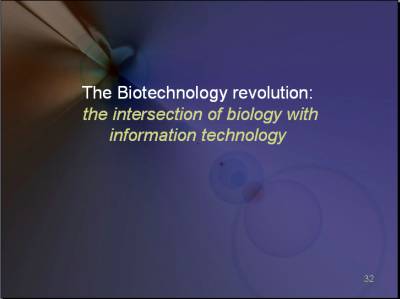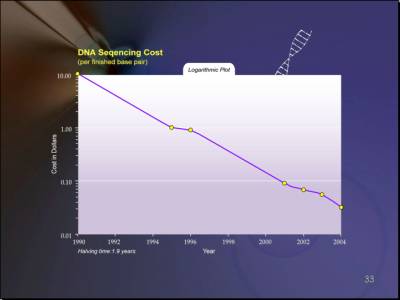How Neuronanotechnology Will Lead to Melding of Mind and Machine
Ray Kurzweil
This article was adapted from a lecture given by Ray Kurzweil at Terasem's 2nd Annual Workshop on Geoethical Nanotechnology on July 20, 2006 in Lincoln, VT.
Entrepreneur, author, futurist and producer, Ray Kurzweil, deftly explains a path to understanding the basic principles of human and artificial intelligence, and reverse engineering of the brain in attempting to copy intelligently biological subsystems and brain uploading.
Brain uploading is a complex issue because it comes after some of the other developments. I very often talk about GNR: genetics, nanotechnology and robotics. G is Genetics- basically reverse engineering biology and reprogramming. N is Nanotechnology- basically bringing massively parallel self organizing programmability to matter and energy. R is robotics, which really stands for general artificial intelligence, so-called strong AI. This is AI at the human level, which I pointed out earlier, would not be necessarily beyond human levels, because it would combine the strengths of human and machine intelligence. Anytime you use Google, or in many other examples, the advantages of machine intelligence are evident. But brain uploading goes beyond that.

Image 1
GNR will unfold in that order. We are now in the golden age of reprogramming biology. Nanotechnology is not at that level yet of programming, although I will point out many examples of being able to build complex systems at the molecular level that are performing complex functions already. And in robotics -artificial intelligence- we have many impressive examples of narrow AI. [1] The narrowness will gradually give yield to general intelligence, [2] but that’s further off.
And brain uploading is even more daunting. We could create an intelligent entity, one that’s convincing at the human level, which is a very broad span of abilities and a broad array of capabilities. Consider human musical intelligence: on one end it’s a guy whistling, the other end could be Mozart or Beethoven. There’s a very broad range of human intelligence in each area. So for an entity to pass the Turing Test, [3] it’s a very fuzzy horizon. Brain uploading is recreating a specific person; I think it’s a much more demanding capability.
You could in theory say, well, we don’t have to understand how general intelligence works, we could just methodically copy each of the structures and the final entity would then preserve the capabilities of the original even though we have no overall idea of how that system works.
I think that’s very unrealistic. You have to understand what the salient features are that we’re copying of an individual,  because it’s not feasible to recreate an individual at the atomic level. You would have to understand which issues are important and what we’re looking for. The thing that we’re going to have to understand is the basic principles of human intelligence to do brain uploading. But if I have general AI- human level AI- in 2029, I have brain uploading not until the 2040’s, although I do believe it will be feasible.
because it’s not feasible to recreate an individual at the atomic level. You would have to understand which issues are important and what we’re looking for. The thing that we’re going to have to understand is the basic principles of human intelligence to do brain uploading. But if I have general AI- human level AI- in 2029, I have brain uploading not until the 2040’s, although I do believe it will be feasible.

Image 2: Reader [4]
I want to start by demonstrating my recent invention to make a few points about the invention and how this fits into my own thinking. This is a pocket sized reading machine for the blind. As previously mentioned, I’ve been in this field for 33 years; I started in 1973. In 1976 I introduced the first print-to-speech reading machine for the blind which had three new technologies of omnifont OCR (optical character recognition), text-to-speech synthesis, and the first flat-bed scanner. OCR was able to intelligently deal with patterns it had never seen before. You could present a whole different type style, which could be quite different than anything it’d seen before and it would be able to intelligently deal with it and recognize letters.
It’s the same as what you would do if you see a capital A you’ve never seen before, because it was looking for the actual geometric features that a capital A has. A has a concave region facing south, it has a triangular shaped loop portion, it has certain connections, and even if the letters were serifed and so on it could intelligently figure that out. It could intelligently separate letters if they’re touching one another, or if a piece of the letter was broken off it could reattach it.
If all the AI systems in the world suddenly stopped functioning, our economic infrastructure would grind to a halt. Your bank would cease doing business. Most transportation would be crippled. Most communications would be crippled. This was the not the case a decade ago. Of course, our AI systems are not smart enough—yet-- to organize such a conspiracy. Strong AI. If you understand something in only one way, then you really don’t understand it at all. This is because if something goes wrong, you get stuck with a thought that just sits in your mind with nowhere to go.
The reading machine is a good example of the Law of Accelerating Returns. It is a thousand times smaller and lighter than the original reading machine, and a lot less expensive. The computer is thousands of times more powerful in terms of speed and capacity, and depending on how you measure this stuff, it’s thousands of times more capable.
 It’s also a good application of applying technology trends. I got involved in modeling trends of technology 30 years ago because I realized that the key to success as an inventor is being able to model and anticipate technology trends, or basically timing.
It’s also a good application of applying technology trends. I got involved in modeling trends of technology 30 years ago because I realized that the key to success as an inventor is being able to model and anticipate technology trends, or basically timing.
We get a lot of business plans, and we fund some projects and do some mentoring. I think 95% of those groups would do exactly what they say if given the funding, and 95% of those projects would fail because the timing is wrong: not all the enabling factors are in place when they’re needed.
So I began to be an ardent student of technology trends. Being an engineer I gathered a lot of data and built some mathematical models. I now have a team of ten people that collect data in different areas. We built models of technology in different areas in information technology, not anything else.
Each industry goes through pre and post information eras. An interesting field that’s now transforming from a pre-information era to a post one is biology. Biology used to be hit or miss. We’d find something out, for example, “here’s something that lowers blood pressure, we don’t know why this works but it seems to work.”
We’ve automated that drug discovery process now, but I think 99 percent of the drugs on the market today were created with no clear model of these biological processes. Most drug development now is rational drug design. This term has been out for a while but it is only recently that we have had the tools and genetic knowledge to do it. The Human Genome Project [5] has been completed since 1993.

Image 3: DNA Sequencing Cost [click for larger image]
And really, we’re in the early stages of this, of reprogramming biology. RNA interference can turn genes off: we can send little pieces of RNA that block the messenger RNA expressing the gene.
Footnotes
1. Narrow AI [Artificial Intelligence] - a kind of AI system that displays Specialized Intelligence in some domain.
Most AI software in history, and under development, fits into this category.
However, this Mind Ontology was created to help move toward the development of Narrow AI's antonym, Artificial General Intelligence.
Many Narrow AI systems are based on the use of individual Learning Algorithms, customized for particular domains.
agiri.org/wiki/Narrow_AI
November 13, 2007 1:39PM EST
2. General Intelligence - controversial construct used in the field of psychology (see also psychometrics) to quantify what is common to the scores of all intelligence tests.
en.wikipedia.org/wiki/General_intelligence_factor November 13, 2007 1:46PM EST
3. Turing Test – a proposal for a test of a machine's capability to demonstrate intelligence.
Described by Alan Turing in the 1950 paper "Computing machinery and intelligence,”
it proceeds as follows: a human judge engages in a natural language conversation
with one human and one machine, each of which try to appear human; if the judge
cannot reliably tell which is which, then the machine is said to pass the test.
en.wikipedia.org/wiki/Turing_test November 13, 2007 1:50PM EST
4. K-NFB Reading Technology, Inc. presents the ultimate solution to your everyday reading needs—the Kurzweil-National Federation of the Blind Reader. This portable device will revolutionize the way you deal with the avalanche of print you confront each day.
www.knfbreader.com/ November 7, 2007 2:50PM EST
5. Human Genome Project - Completed in 2003, the Human Genome Project (HGP) was a 13-year project coordinated by the U.S. Department of Energy and the National Institutes of Health. During the early years of the HGP, the Wellcome Trust (U.K.) became a major partner; additional contributions came from Japan, France, Germany, China, and others. See our history page for more information.
www.ornl.gov/sci/techresources/Human_Genome/home.shtml November 14, 2007 3:49PM EST